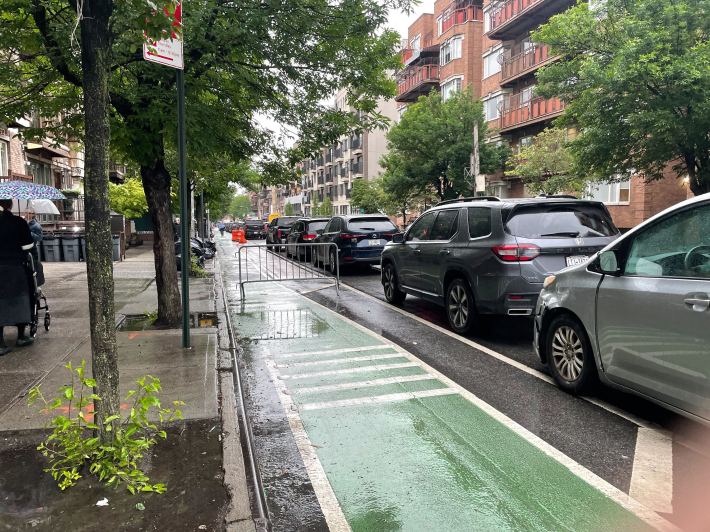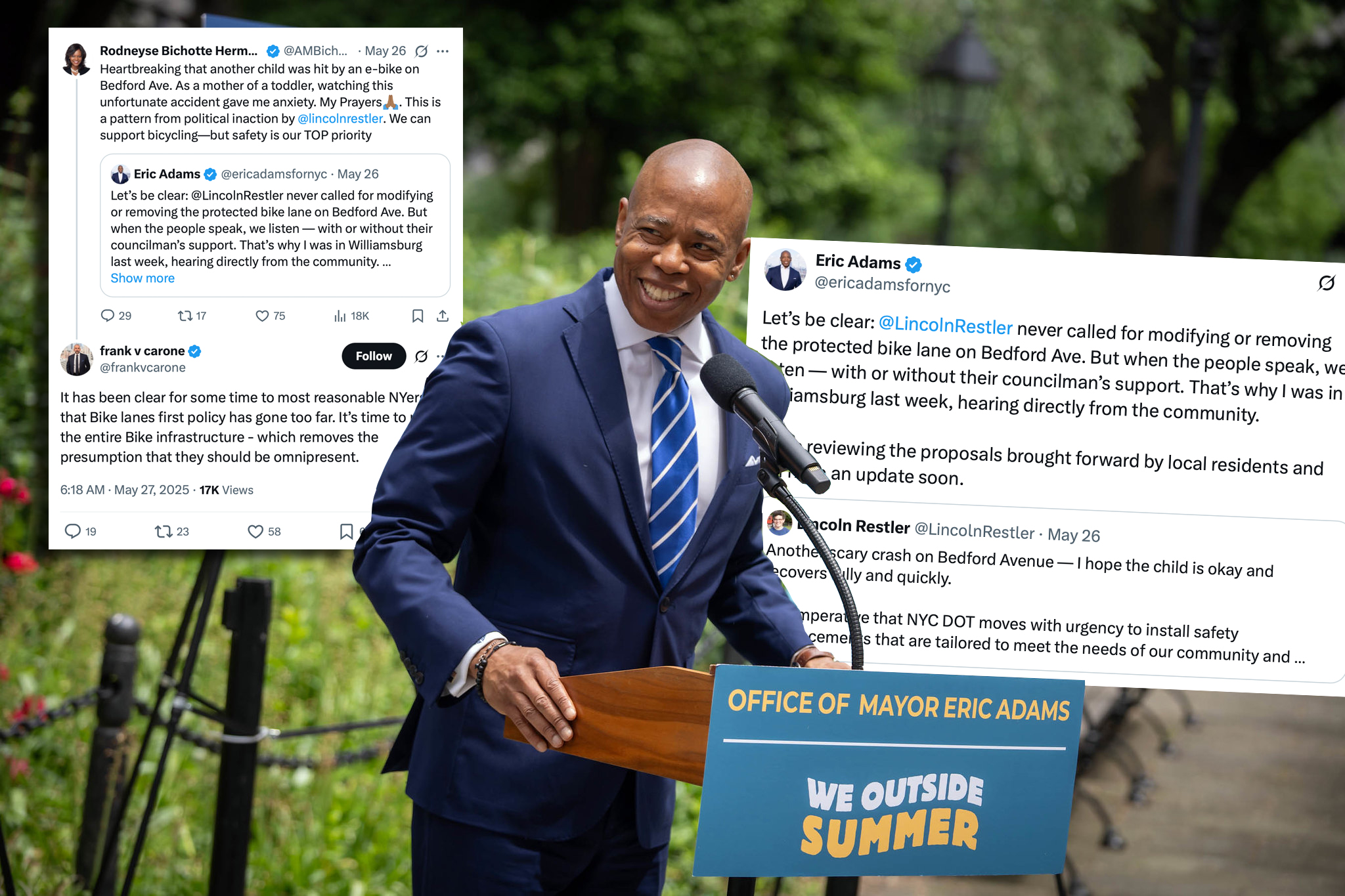Now the call is coming from inside the house.
Mayor Adams claims he's merely "listening" to opponents of a protected bike lane on Bedford Avenue — but on Tuesday, hate was being spewed by some of the mayor's biggest allies inside the Brooklyn Democratic machine, including from his former chief of staff and buddy.
Former Adams insider Frank Carone, and Brooklyn party chair and Assembly Member Rodneyse Bichotte Hermelyn took to X to spread disdain for the bike lane and to criticize local Council Member and bike lane supporter Lincoln Restler (D-Williamsburg).
The Hasidic community has been outspoken in its desire to have the bike lane taken out from Dekalb to Flushing avenues, following some incidents of cyclist colliding with young children who run unaccompanied into traffic from school buses or double-parked cars.
The lane, which was installed between Dean Street and Flushing Avenue by Adams's own Department of Transportation, has enjoyed broad support from Brooklyn residents who use it as the lone safe northbound route. Both Council members representing the bike lane area — Restler and Chi Ossé (D-Bed Stuy) — support it.
And that might be part of the problem.
The statements by Brooklyn Democratic honchos, who have long been close to Adams, but now back disgraced former Gov. Andrew Cuomo, signal that a more car-first policy is coming if the former governor becomes mayor.
“It’s the tip of the bikelash,” said Jon Orcutt, former DOT official and advocacy director at Bike New York.
From online beef, to unsafe streets?
The latest blowup has its roots in Adams's town hall in Williamsburg last week — itself a result of weeks of growing agitation by a Hasidic community that claims the bike lane is a safety threat more alarming than the speeding cars it replaced.
Then over the Memorial Day weekend, the anti-bike lane account Williamsburg 365 News posted a video showing a small child running into the bike lane from behind a row of parked SUVs, and then being knocked down by a cyclist.
Insane! Another child was knocked off this afternoon on the dangerous Bedford Ave bike lane, which continues putting bike riders and pedestrian lives at risk. pic.twitter.com/wACdioLBT9
— Williamsburg 365 News (@Williamsburg365) May 26, 2025
Restler posted about the crash, asking the administration to “move with urgency” to address some few remaining issues with the bike lane he supports — supported that has already cost him in the Hasidic portion of his district.
The post caused a ripple effect of anti-bike replies.
Hermelyn said the incident shows a “pattern of inaction” from Restler:
"Heartbreaking that another child was hit by an e-bike on Bedford Ave. As a mother of a toddler, watching this unfortunate accident gave me anxiety. My Prayers🙏🏾. This is a pattern from political inaction by @lincolnrestler. We can support bicycling—but safety is our TOP priority."
Then Carone chimed in, voicing his disapproval of the city's move towards safe cycling infrastructure.
"It has been clear for some time to most reasonable NYers that Bike lanes first policy has gone too far. It’s time to reset the entire Bike infrastructure — which removes the presumption that they should be omnipresent," he wrote.
On Tuesday, Streetsblog asked Mayor Adams if he shared the opinion of his former chief of staff and political ally — whom he celebrated as a "gritty, opinionated New Yorker."
“I like bike lanes, but have we put bike lanes in places where communities say ‘We don't want them,’" he said, referring to bike lanes that he, in fact, put in.
"When I came to office, I told the DOT that you have to listen to communities and not just do what you want to do because if you put a bike lane somewhere where communities overwhelmingly don't want them, that's a problem, like Williamsburg."
Hermelyn and Adams are no strangers to criticizing Restler. The former traveled far out of her district last year to object to the McGuinness Boulevard bike lane, also in Restler's district, and is backing Restler’s challenger Sabrina Gates's last-minute Council bid to defeat him.
Gates told Streetsblog that she supports the general concept of bike infrastructure, but agrees that the lane should be re-routed to Classon Avenue between DeKalb and Flushing avenues.
“I think for now that is the safest,” she said. (Fact check: it is not. Classon Avenue is an off- and on-ramp to the Brooklyn-Queens Expressway; in the five years between 2020 and 2024, there were 156 reported crashes on the single block of Classon between Park and Kent avenues, injuring 63 people, according to city stats. It is not a safe place.)
The Mayor revived his campaign X account to slam Restler, saying that the Council member never called for “modifying or removing” the bike lane and praising himself for holding a community meeting on public safety in the heart of Williamsburg last week.
Restler does not support such a major change to the bike lane as Gates but has asked the DOT to do more, such as making a few design tweaks and finally doing some community engagement to encourage residents to drive safely, not double-park and prevent their children from running into traffic. At a Council hearing earlier in May, he asked the DOT if it has considered any more safety improvements for the bike lane.
"We don't have protected bike lanes in that community, so there's been some learning curve," he said. "I think we all know that when protected bike lanes are installed, it makes streets safer for drivers, cyclists, pedestrians, but we clearly need to do more in this community to make a difference."
Community enragement
In the lead up to last week's “community conversation” about public safety in Williamsburg, pamphlets circulating in Yiddish urged the community to come to the meeting and emotionally share their safety concerns about the bike lane.
“It’s important that the mothers of the small children as well as the mothers who take children off the buses should try to come on Thursday,” a flier read in Yiddish.

But the night was not filled with emotional testimony against the bike lane. Very few women from the community were even present. Instead, established leaders like Rabbi David Niederman, the president of the United Jewish Organizations of Williamsburg, told the Mayor that the DOT should rip up the DeKalb to Flushing section where, he said, around 2,500 school children get dropped off and picked up.
The mayor was non-committal, punting to DOT Commissioner Ydanis Rodriguez, who made it clear that the bike lane is working.
"One thing that we should note is that before this bike lane from 2018 to 2022 … this is the area that had the second largest numbers of pedestrian fatalities and crashes in the city,” he said.
Yet the Hasidic community has been fighting it, with some even putting up official-looking signs falsely telling cyclists that the bike lane is closed during school pick-up and drop-off hours.

Streetsblog has also witnessed locals intentionally blocking the bike lane with barriers, and even cinder blocks, creating a dangerous situation for cyclists.

But the community outrage about safety is limited solely to the bike lane. When 10-year-old Yitty Wertzberger was killed by a speeding driver on her way to school a year ago, just blocks from the site of the community meeting, there was no outrage. The Transportation Committee of Community Board 1 met just two days after the tragic death, and not a single member of the public showed up to discuss the incident or call for change.
In fact, mothers who Streetsblog spoke to after Yitty's death took an "accidents happen" attitude, and used the opportunity to say that the real "danger" were e-bikes.
Conflicting policy
Adams's public statements about the Bedford Avenue bike lane are inconsistent with his campaign promises and presentations from his administration that claim bike lanes unequivocally equal safer streets, for everyone.
Adams vowed in 2021 to as mayor build 300 miles of bike lanes in his first term, but he has fallen way short of that goal, and has also fallen short of the mandated quotas of the Streets Master Plan. The Bedford Avenue lane was among those bogged in delays before construction started in 2024.
And the bike lane isn’t dangerous. In fact, according to the DOT’s own data, protected bike lanes like the one installed on Bedford Avenue make for safer streets. The roadway narrowing discourages speeding, a prolific problem on Bedford Avenue, and in turn reduces pedestrian injuries by 21 percent.
The project area used to be extremely dangerous for both cyclists and pedestrians. Bedford Avenue is a Vision Zero Priority Corridor with 29 people killed or seriously injured over a five-year period (2016-2020).






